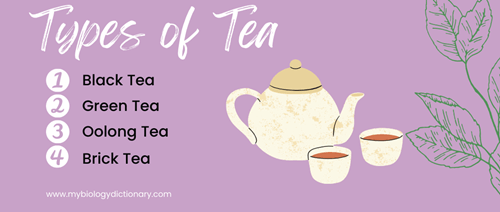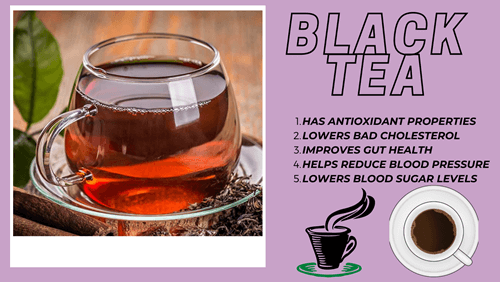Types of tea based on processing

Ever wondered how many types of tea exist? Let’s find out!
It is rightly said, “Tea time is a chance to slow down, pull back and appreciate our surroundings”. Tea is a refreshing and stimulating non-alcoholic beverage. It is enjoyed by over half of the world’s population. However, the types of tea different people like vary.
The legendary Chinese emperor Shen Nung is said to have discovered the stimulatory properties of tea leaf extract around 2700 BC. Commercially, four main types of tea exist in the market. Drinking tea has always been encouraged a lot since ancient times because of its incredible health benefits.
Table of Contents
Black Tea
Certainly, this is one of the most popular among different types of tea. It is mainly produced in India and Srilanka. The manufacturing of black tea involves four major steps namely withering, rolling, fermenting and drying.
The freshly picked shoots of Camellia sinensis that arrive in the factory are spread out on nylon nets or on trays. Special care is to be taken so that the leaves don’t get injured otherwise premature fermentation will set in.
Processing
Wilting is accomplished either in open sheds or in special sheds with controlled heat and ventilation. The time duration for this process is 10-12 hours and the optimum temperature for the same is 30°C. The moisture content of the leaf is specifically reduced to 50-60% during the withering process. To rupture the cells, they are passed through rollers under high pressure. This also leads to the liberation of sap and enzymes.
Fermentation houses are specially designed for the process of fermentation where air, temperature, circulation and humidity can be regulated. The optimum temperature range for the fermentation process is 24°C to 27°C along with a humidity of about 90%.
The partially fermented mass of leaves are collected and special trays and are covered to keep them warm. The leaves develop a characteristic aroma and special flavour during fermentation. Moreover, the process of drying involves exposing the leaves to a current of extremely hot air for a time duration of 20-25 minutes.
Only 3-4% moisture content is left in the dried product. After this, vibrating screens are used for cleaning and sorting leaves. Once the sorting is complete, they are traditionally packed in plywood chests lined with aluminium or tin and are shipped.
The waste product left after sorting is termed fluff. It is also sold since it is useful in the extraction of caffeine.
CTC (crushing, tearing and curling), Legg-cut and Rotorvane are some of the modern-day leaf distortion systems.
Green Tea
Green tea is made by brief heating the freshly picked leaves by steam in Japan or in an iron pan in China. It is particularly the health king amidst various types of tea. The purpose of heating is to inactivate the enzymes.
Rolling and drying processes are carried out with the leaves similar to the processing of black tea. After that, they are polished with soapstone or French chalk to improve their colour. The final result is dull green leaves with even quality.
Comparatively, the tannin and caffeine content is higher in green tea. Green tea is scented with blossoms of aromatic plants by mixing the flowers with the dried tea leaves.
Another key point is that it is rich in antioxidants which rejuvenate you. It helps maintain cholesterol levels and keep your heart in good health.
Oolong Tea
This is a partially fermented product from a special form of China teas, chesima. Oolong tea is prepared almost entirely in Taiwan. It is consumed mainly in America. This type of tea is considered the intermediate between green and black tea.
It has the flavour as that of green tea and colour as that of black tea. The characteristic flavour of oolong tea is due to the special variety of tea grown in Taiwan.
The climatic and soil conditions are also responsible for its unique flavour amidst numerous types of tea.
Brick Tea
This is prepared from the waste left after the preparation of black and green teas. In comparison to other types of tea, Tibetan people love Brick Tea. It consists of stalks, coarse tea dust and even twigs. They are softened with steam and are compressed into bricks.
To summarize, most tea brands prepare mixtures that combine various types of tea and they are blended at a professional level.
Comment down your favourite type of tea! Keep up the hunger for interesting facts and stay tuned for MBD’s new article because our website is totally your cup of tea.
Team MBD
Check out
Stock up your kitchen- Tea Exporters & Suppliers – Tea Brands – Wagh Bakri Group (waghbakritea.com)
Also, we bet you will love this one- Did you know our DNA is 99.9% same? – My Biology Dictionary





